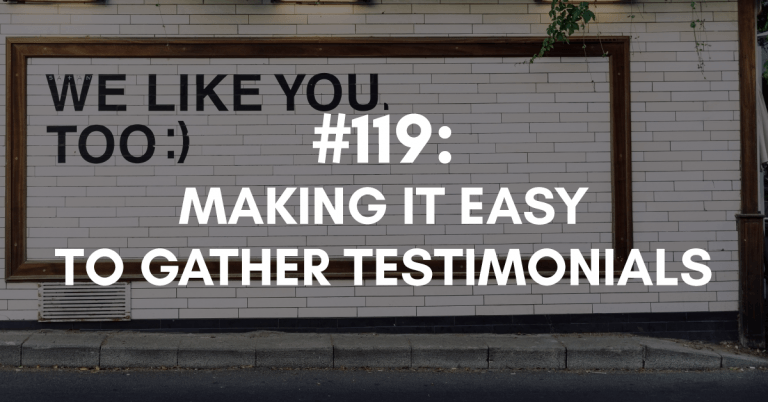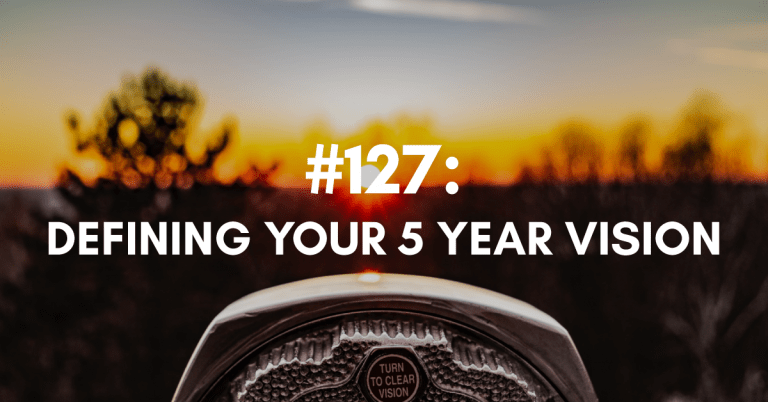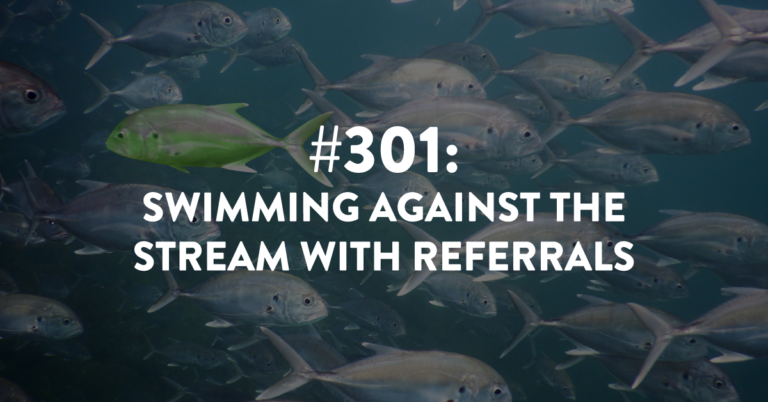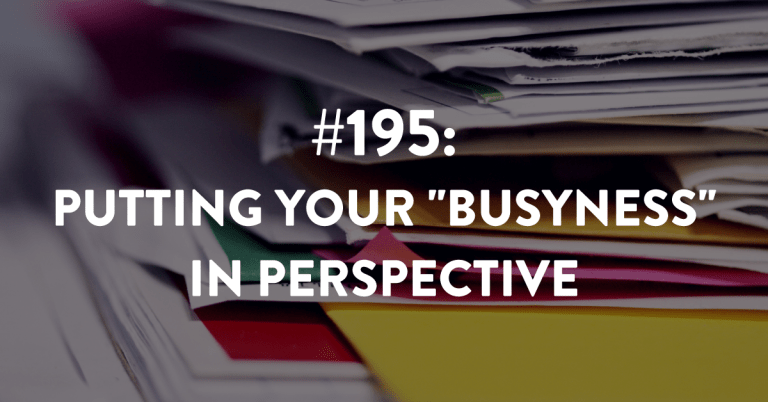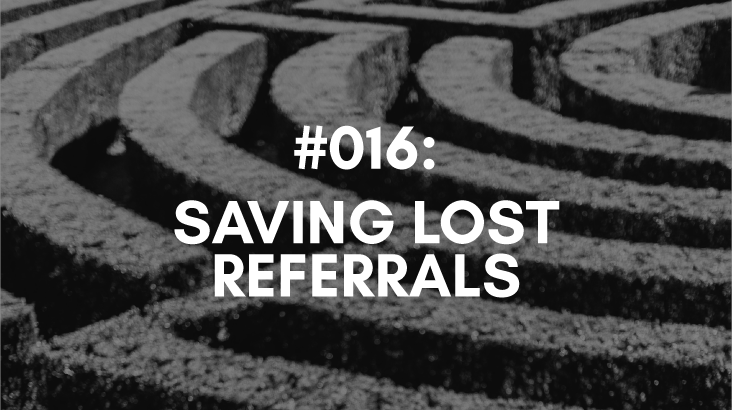Ep #311: Breaking Down the Science of Referrals
If you are tired of awkward and ineffective referral tactics and want to grow your business without compromising your relationships, you need to understand the science behind how referrals work.
Focusing on authentic connections, respecting your relationships, and applying science-backed strategies are crucial elements in successfully generating referrals.
Here are three things to keep in mind:
Referrals Aren’t About You: When someone refers a prospect to you, it’s not about you. It’s about them being the hero by helping someone solve a problem. Understanding this dynamic can help you build stronger referral relationships based on trust and genuine connections.
Reputation is Key: When someone refers you, their reputation is on the line. Your referral sources trust you to provide value to the prospects they refer. It’s essential to maintain and nurture this trust by respecting the relationships, showing gratitude, and delivering on your promises. Building trust is the cornerstone of successful referral generation.
Relationships Matter: The type of relationship you have with your referral sources directly impacts the consistency of referrals you receive. By focusing on priming, reciprocity, surprise and delight, and maintaining genuine connections, you can cultivate strong and lasting referral relationships.
Remember, referrals are not just about asking for them – they’re about building genuine connections and providing solutions. Referrals are also not just a means to grow a business but a way to make a positive impact on people’s lives and build a community of support and collaboration.
Links Mentioned During the Episode:
If now is the time to start generating referrals, then submit your application to join the Building a Referable Business coaching program.
Want me to build your Referral Strategy for you? Then check out my VIP Referrals In A Day service where I handle the heavy lifting for you. First step is to apply to see if you’re a fit and then we’ll schedule a call. (*A minimum of a 2-person team is required for this Done-For-You service.)
Next Episode:
Next episode is #312, which is another episode created with you and your needs in mind.
Download The Full Episode Transcript
Read the Transcript Below:
Stacey Brown Randall: Nothing is worse than smoke and mirrors when you want to learn how to solve a problem in your business. If you want to solve the problem of inconsistent or sporadic referrals, then you need to understand the truth, which is based on the science of referrals and definitely not smoke and mirrors.
Hey there, and welcome to episode 311 of the Roadmap to Referrals podcast, a show about helping you build a referable business. I’m your host, Stacey Brown Randall. My journey from a business failure to a successful business now 10 years in, I know generating referrals naturally and consistently has made all the difference. Working with clients around the world, we leverage the science of referrals, protect relationships above all else, and help you build a referable business.
I am excited to do this episode today because I am going to talk about science. And I know for some of you, that was like your least favorite subject in school. Well, that and math kind of were for me. But this is going to be really interesting.
And if you’ve been listening to this podcast for a while, you’ve heard me talk about the fact that how I teach my referral strategies and why my clients and my own business have success is because what I teach is rooted in science.
So you may have heard me talk about it. You definitely probably heard me mention it, but if you are new around here, this may be very, very new. And maybe, maybe a little mind blowing when you think about actually what goes on behind the scenes, when referrals are actually being made, like what does it take to make them happen with consistency? And of course, with the right sustainability.
So we’re going to talk about the science piece. And I think it’s really important that people understand that I didn’t figure out the science piece first. I figured out what was working, what the trainings that I teach now, the strategies that I teach inside my coaching program and in my VIP, what I figured out was what worked for my business, but it was like the strategy and the language and the do this and then this, right?
That’s what I realized first worked for me when I got 112 referrals that first year in business 10 years ago now, actually just over 10 years ago now. We’ll hit 11 years later this year.
And so when I discovered that it was working, I didn’t know exactly why. Like, I had a good indication, and I had some gut reactions and responses to why I thought it was working. And then when I started applying it to my clients’ businesses, when they were like, hey, teach us your referral stuff, I was like, OK, let me figure out what I’m doing, right?
And I had to build out the strategies and the systems, and I had to put everything together, all the processes and things like that together. And I started teaching it to my clients, and then they started having success.
And while I did know that we were doing things differently, and I did know that the not asking for referrals was 100% what set me apart and made me different from 99.99999% of everybody else out there who are teaching referrals, what I really realized as to why it was happening, first came from just gut reactions.
And then as I did more digging into, well, what am I teaching and how are we doing it and how are we applying it, and let’s really get to the heart of why it’s working, the science stuff just like opened up before me. I was like, oh, my gosh, of course.
I do think it’s one of the reasons why my master’s degree in communication came in so helpful for me as I was doing this part of, like, really understanding, like, okay, why is this the referral tactics and strategies that I’m teaching to people, why is the philosophy, right, and the strategies that I’m teaching to people working other than just kind of knowing and having a gut reaction and kind of seeing some dots connect and some and understanding I can reverse engineer some pieces.
But having that master’s degree and really spending time investigating why things are the way they are, and particularly doing that in the space of communication, it really helped me very quickly latch onto the fact, oh, wait, there’s something else going on here that I didn’t anticipate, I didn’t intend for, but it is absolutely at work.
And uncovering that is what makes me, with that confidence of what I teach, is because I know it’s not actually based on Stacey. It’s not based on some Stacey success or the, you know, hundreds or thousands of people that have read my book and gone through my programs and applied what I do.
Like, it’s not really me. It’s actually science. I just stumbled upon it and then uncovered it. And so I want to be really clear of like the order in which that the science piece was uncovered and discovered.
I didn’t start with it, but once I realized what was happening, you better believe I figured out how to work that into what I was teaching so that everything we taught was based on science and that we could then indicate as to why it would work.
We never guarantee how quickly it will work. We do have people who come into my coaching program or my VIP program and get all the referrals they want in one year, and they do it in 90 days, which is awesome.
I have an interior designer that I’ve been working with. She got five referrals in one week. And we weren’t even, I think we were two months in. She was like, I got five referrals this week. I’m like, holy cow.
And she actually closed, and that’s just in her first 60 days. And she’d already had five or six referrals come in right after we first started working together, just putting some of the things in place that I talked to her about, and she closed a couple of them, and we’re talking well over six figures in revenue, which, of course, she made her ROI back in working with me. She was a VIP client.
But the idea here is to understand and to really make sure that you are with me on this journey in terms of how it all came to be, why what I teach works, and it isn’t just because I like woke up one day and was like, I’m now brilliant when it comes to referrals.
I put some things in place. I figured out why they were working. I really started to follow every thread possible that would lead me down a path that would be science in nature. And I made sure that other people understood that we do this, we say this.
Like when I’m talking to my clients, it’s like, say this, do this. This is how I want you to approach this situation. That’s not all rooted in just because Stacey says so. I mean, it probably comes across that way to my clients, like, Stacey told me to say it this way, so I’m going to, right? Make sure it sounds good to me, and I’ll go do it.
But it’s actually because what I’m saying is rooted in the other person on the receiving end who’s going to receive whatever I’m telling somebody else to say, but also, it’s rooted in science. And so I felt like I needed to dedicate an issue to unpacking that.
So let’s dive in. Because the traditional approach, as you guys know, I beat this drum a lot. The traditional approach to referrals is broken. It is very, very broken. And it has been broken, I think, since the absolute beginning when people first started talking about referrals and how you should get them.
And that traditional, like old school approach, that awful advice that you hate, I hate, everybody should hate, maybe not everybody does, but they should, is that number one, you have to ask for referrals. Ask your clients, ask your prospects, ask your neighbors, ask your friends, right? That you have to constantly be asking.
We are also told another awful old school approach that we’re told is that we have to incentivize or pay kickbacks for referrals, right? That’s another one that gets people and they’re like, I do not want to operate and play that game. Well, you don’t have to.
The other one that I hear a lot is that you have to be really gimmicky. So there’s people out there who will teach you to be gimmicky, like, hey, write a book and then give that book to everybody and tell people to, like, give 10 copies to everybody and say, hey, will you send out my book to other people you know?
It’s like this gimmicky way of trying to get people to refer clients back to you. It’s just, there’s so many like that, it drives me insane.
But some other gimmicky stuff that I see people do is if you’ve ever put in your email signature, the greatest compliment you can give me is a referral, or you send out a postcard with the words, I’m never too busy for your referrals, or don’t keep me a secret, right?
It’s that being really gimmicky. and really overly promotional. And it just doesn’t work the way ultimately that people want it to because it’s flawed. And we’re going to break down how and why these old school tactics are flawed when we get to the science piece.
But the last one I want to make sure we talk about that people are taught over and over and over again, that old school traditional approach is that you’ve just got to network a ton so that a ton of people know you and they’ve got to always see you like you’ve got to always be out and about.
Tell that to a working parent who has a bunch of kids at home and a spouse that they would actually like to see. Right? Or tell that to somebody who is working, growing their business, and then also dealing with an aging parent. Or basically anybody who just wants to have a life.
The fact that you’ve got to always be networking, always be seen. People will forget you if they don’t see you every week. You’ve got to show up. You’ve got to be there every single Tuesday morning. Nobody in their right mind has time for that in the long run. Even if you’ve done it in the short run, you probably know, like, this cannot survive forever, right?
And so these are those old school tactics that have been taught. The asking, the paying, the being gimmicky and promotional, and the networking a ton so you can be remembered. And these approaches, they’re awkward. They’re painful. They’re inauthentic. And we all know this. They just don’t work.
But here’s the rub we always have to pay attention to. The rub is that we want to grow our businesses by serving more clients. I’m assuming that’s why you started a business is to help people, right? And to also make money. Those two things can go hand in hand, and they are great two things to have it as a business owner, right?
You help others using your mix of expertise and education and experience. The three E’s expertise, education, and experience, right? We help our clients by using our own mix of our own expertise, education, and experience. And we all know that referrals are the best way to grow your business, right?
I like to call it the holy grail of growing a business with ease. Because we know the benefits of clients that have been referred to us, or their prospects first. Prospects who have been referred to us that eventually will become paying clients, right? Because referred prospects, they know they have a problem and they are open to looking for a solution, which is why they were willing to be connected to you.
And they show up being connected to you by someone they trust, which means that they trust you as well, which makes them less price sensitive and typically sometimes easier and quicker to close. Now, that doesn’t mean you don’t still have work to do gaining and earning their trust, but a big part of that trust factor is already there.
Referrals really are the easier way. They are the easiest way to generate new clients. But let’s be honest, we would all rather do just about anything other than tired, awkward, yeah, the old school traditional approaches to generate referrals. Why is that?
Well, at the heart of it, at least it is for me, and it is for my clients and the people that I work with, it’s because we know we shouldn’t have to compromise who we are, and our relationships with other people to grow our business.
At least we believe that we shouldn’t have to. But we’re out there looking for a solution that’ll help us grow our business without compromising ourselves and compromising our relationships. And this issue is real.
And when it came to referrals, everybody was teaching strategies that really made most people feel like they were taking advantage or compromising or looking desperate and awkward when they were trying to get referrals from other people. And it’s been a problem for a really, really long time.
Which is why I’m so blessed and so thankful that I get to do what I do, because when we think about understanding referrals, from my perspective, it makes it real for others. And I love that. And of course, that’s a big part of why I love what I do.
So when we talk about the traditional strategies, being in direct conflict with what you want and for most of us are willing to do, it’s a very real issue and it’s one we have to figure out how to solve.
And so I want to walk you through the science, like the science behind referrals and then how we are able to use that science to really help us build out approaches and strategies and tactics and language that not only feels good using, but also works, because you really need both. It can’t just feel good and not work, and it can’t just work and feel terrible. We really need both pieces.
So when we talk about our science-backed solutions for how we help our clients generate referrals naturally, which is without manipulating, without incentivizing, and definitely without asking or any of those other tactics, it really does come down to three things.
So let’s go through those. Okay, number one, referrals aren’t about you. I need you to hear me say this again. I say this a lot on this podcast. Referrals are not about you.
When a referral is being given, it is your referral source, the person who’s going to refer a new prospect to you, your referral source, is talking to another person or understanding that another person that they know has a problem.
And in that moment, they get to be the hero to the person that has a problem. How they get to be a hero is by helping that person solve their problem. And then that’s when you enter the equation.
So it’s important for you to understand your place. You’re not the most important person when a referral is being made. Actually, they’re not about you at all. But the referral source, when you think about this, they know who the prospect is. They know that a prospect has a problem and then they’re willing to connect that person to you because your place in this process is just the solution provider.
The most important person in this whole cast of characters isn’t the prospect either. It’s not you as the solution provider and it’s not the prospect who will hopefully become a client and give you money, right? It’s the referral source.
And in the moment that that referral source is saying to someone they know, I know how to solve this problem, I’m gonna refer you or I’m gonna connect you with so-and-so, it’s about helping the person who has a problem. It’s just a bonus that your business is going to ultimately grow because you’re potentially getting a new client.
What this is from a science perspective is what’s going on in the brain. What’s ultimately happening in the brain when your referral source is like, hey, I can be a hero. I can help you. I know I can refer you to someone who can solve this problem, right?
It hits on, that being the hero is what releases those feel-good chemicals in our brain that is determined by scientists to be called ‘the happiness trifecta’. And it’s the three chemicals in the brain, I like to call it dopamine and the two cousins, that are released, those feel-good chemicals that are released when they’re helping someone.
But the help they’re providing isn’t to you with a new client. It is to a person who has a problem. And they’re going to help that person solve that problem, which is where it is real and genuine and pure. But how they’re going to help that person solve that problem is then, enter you, by referring them to you.
So the first thing I need you to understand is that referrals aren’t about you, and it has a lot to do with what’s going on in the brain, right? The chemicals that are triggered and released when we are helping someone. Right? Helping someone who has a problem by providing a solution. But never forget in the equation, you’re just the solution provider.
Okay. The second thing you need to understand is that there is a reputation on the line. When we talk about referrals, we know that. That’s the piece most people get is understanding that in the science of referrals, there is this thing called the psychology of trust.
There’s also a piece of this that goes along with the science of social networks as well. But there’s a reputation on the line, and so we have to understand that. Most people think how you maintain that reputation and manage that reputation is by making sure your referral source knows how amazing you are at what you do.
That’s not the relationship they’re interested in having with you. They’d love a relationship where you don’t ghost them for nine months, right? You don’t take their referrals for granted. Yes, of course, you need to take good care of anyone they send your way, but they don’t need to be trained to be told exactly what it is you do and how amazing you are.
They need to trust you. They need to trust that you will be able to help the person they send to you, or you’ll tell them if you can’t, right? And that relationship that they have with you is actually maintained in a very different way than most people think. Most people think, well, I’ve got to go to coffee with them every month, or I’ve got to send them a text message every month to make sure they know I’m not forgetting about them. That’s not it.
That’s not going to actually generate the referrals that you ultimately want from folks, if all you’re doing is worried about, I got to take you to coffee every month, or if I get super busy, then I ghost you. Both of those things are not necessary. Obviously, the ghosting is really bad.
But it’s understanding that they are putting their reputation on the line when they refer to you. And you’ve got to protect that. You’ve got to respect that. But understanding that that trust factor and that psychology of trust that comes into play, it’s actually built there until you lose it. So the relationship you maintain with them is one of connection.
And that brings us to the third piece, the final piece of our science-backed solution. And that is really understanding that the type of relationship that you have is key and how you connect and how you care for the people who refer to you or the people that you want to refer to you, is directly related to your consistency of receiving referrals.
And there is a right way of doing it, an authentic and a genuine way. And it’s actually rooted in behavioral economics. And at a high level, it’s kind of like understanding priming, reciprocity, and surprise and delight, and definitely variety as well.
But when I use words like that, priming and reciprocity, most people think about those things and they immediately in their mind think about how we’re going to take advantage of people and go evil with those things.
Please know that has no place. It has A, no place in this world and B, no place in generating referrals and no place in what I teach. I do know people take good and then they turn it evil for their own purposes. But that’s not how we work.
And that’s not how you’re going to build the right relationships with the right consistency. And that long-term success, but also that long-term relationship that you’re looking to build and develop.
And so what most people don’t understand is that when you ask people for referrals, or that you offer to pay someone for the referrals, it usually, or you’re trying to be gimmicky and promotional or networking all the time, it usually backfires because you’re violating the science here.
You’re trying to artificially create or manufacture what doesn’t actually exist, is when you’re violating the happiness trifecta by telling someone, hey, you should refer to me. Well, you just eliminated happiness trifecta because now if they’re going to do it, they got to go find someone to refer to you. And that’s not how something occurs naturally.
And the actual happiness trifecta, that science base that’s going on in our brain, the brain science can actually work.
And then, of course, if you don’t care for these people the right way and you’re not really around and you kind of ghost them and you don’t thank them properly and you’re not maintaining the right relationship, you’re breaking the psychology of trust. That’s a big one, too.
And then, of course, the behavioral economics come into place. And if you’re not doing things that really protect, but also strengthen and deepen and cultivate the type of relationship, it’s just not going to work the way that you want it to work.
So the methodology and processes and strategies that I teach, combine happiness trifecta, the psychology of trust and behavioral economics, plus a few other things that really help us to generate more referrals. But we do that in a way that is respectful to the people on the receiving end.
Here’s what no one ever really talks about with referrals. When someone refers someone to you, they really want it to be their idea. They don’t want it to be your idea to refer to you.
They want it to be their idea, that they’re talking to someone, they come across a problem, and they’re like, oh my gosh, I know exactly who to refer to you. It’s their idea in that moment, right? And of course, they are glad that they do help you get a new client, it’s just not the leading reason of why they do it.
So when you ask people or offer to pay people to refer you, you’re taking away their opportunity to make it their idea. Now, of course, this is hitting at the, like, high-level part of what it really looks like to understand the science and to really understand the science of referrals and how we teach it to folks.
And we’re definitely, like, I’m definitely just kind of scratching the surface here of how we use language and how we use what we do to care for our relationships and how we do our outreach, right down to the cadence of it. Like, all of that It comes into the solutions that we provide or that I provide to my clients.
And so when you’re thinking about trying to generate more referrals, no matter who you decide to get your advice from or what you come up with on your own, if you’re going to DIY it, without working with someone to show you the way, just remember that how you apply whatever it is you’re doing to generate referrals, if it’s not mine, they need to follow some fundamentals because this is how our solutions are applied to our clients.
They all follow these same fundamentals, right? Number one, everything is taught step by step. I break it down, and I go step by step. Because if I’m jumping around, you’re going to get confused. And if you’re confused, you’re going to do nothing.
And so I don’t even, sometimes when I’m teaching the different parts of how the strategy works, I don’t even dive into the piece of the science behind it, right? My clients know there’s science in here. Like, just tell me what to do. But that’s what they’re ultimately after. But we’ve got to go step by step. So make sure that you’re going step by step when you’re trying to understand how referrals ultimately work.
Number two, make sure what you do, it is actually customizable to you. If you’re given one script and one way to say something and one way to do something, it may not work for you.
Now, the truth is, there are parts of what I teach are the same, and it doesn’t matter what industry someone is in. A thank you card is a thank you card, people, right? But sometimes when we’re getting into the nuances of things, how an attorney will apply something will look different from how I have an interior designer apply something.
Or it will look different from how I have a real estate agent apply something to maybe how a business consultant or a business coach apply something. So there’s got to be a level of customizable, even if a lot of it is the same.
And the third thing it’s got to do, please make sure whatever you do, if you’re trying to generate referrals, it’s going to respect your relationships. Because it’s people who refer you. and they are your people. And whether they are your best clients or an old colleague or someone you’ve just known for years and years through networking, they are your people and they deserve to be treated with respect.
So make sure whatever you do not only honors you, but definitely honors them as well. And that’s just one of the, when you think about those things, you think about the science behind referrals and then the fact that what you’re doing has gotta work for you and your business and respect your relationships.
You can see that there’s a lot of problems when it comes to those traditional old school approaches to generating referrals, the icky, awkward approaches that are like one size fits all. Because that’s not how referrals work.
Your referral strategy, your referral approach, it should work for you and it should work. Meaning it should feel good and it should actually provide you what you’re ultimately after as well. Those things are important, and you need to make sure that you’re doing them the way they’re supposed to be done.
Now, if you’re wondering, yes, everything we’re talking about here and so much more on this episode with the science behind referrals is what we have built within our strategies, and our tactics, and the trainings that I provide to business owners.
And I do that in a couple of different ways. And of course, one of those is probably the most popular one, which is my Building a Referable Business coaching program. And it is where people get to go through the process, step-by-step, in 90-day action plans.
So every 90 days, they know what they’re working on, they know what they’re focused on, which strategy they’re implementing, and they get to start having some amazing success. And we do that inside my coaching program.
The coaching program, BRB for short, Building a Referable Business, is really the place where people come into the program, they do an onboarding, one-hour call with me, that we review their pre-work, we figure out what they’re going to focus on their first 90 days based on their highest and greatest need and what could potentially get them back the best ROI for the investment they just made in joining BRB.
And then also kind of like fix their house, get some things in order that they need to get in order. And everyone kind of goes at their own pace. But the coaching program allows for you to implement, to learn and implement, and get feedback from me and test and then learn and implement and get feedback from me and test multiple times because we’re together for an entire year.
So there’s pacing involved and you’re able to go at your own pace, which is really important for some business owners, particularly the smaller that your business is.
So if you’re interested in really digging in more and understanding that science behind referrals, or really just understanding, hey, the strategies are built with the science, so what are the strategies? What do I say? What do I do? What does this look like? And how do I strategy stack these different strategies together?
Well, the first thing you need to do is apply. You need to apply to join me inside the coaching program. Just go to StaceyBrownRandall.com/referable and that’s going to take you to a page that’s going to explain the program to you.
It’s going to walk you through what is included and what access to me do you get, which is a big question people have. And let me tell you, it’s weekly. And there are unlimited one-on-one calls with me throughout your 12 months with me.
I have amazing clients. No one takes advantage of it and tries to book one every single day or even every single week. So it’s good. It’s still available. But it really allows you to go at your own pace.
And now is probably the best time for you to get started so that we can start generating referrals and get that going right now in the middle of the year so you can have a strong finish to not only this whole year but have you set up with great strategies in place for an awesome next year as well.
So the first thing you got to do though is apply because we do keep the group size small and I know exactly who my strategies work for and I need to make sure that you’re the right fit before you come into the program. So first thing you got to do is submit your application.
Alright, again, the show notes page for this episode is StaceyBrownRandall.com/311. We will have the link to the Building a Referable Business Coaching Program as well if you want to submit your application. Or if you want to work really fast and have me build everything for you, there’s information there too for you to submit your application for my VIP Referrals in a Day offer as well.
But we’re back with another great episode next week created with you and your needs in mind. Until then, you know what to do, my friend. Take control of your referrals and build a referable business. Bye for now.


